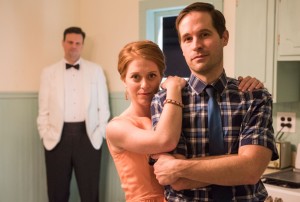
Production photo; audience photography is not allowed
In Chicago I made a point to see Windy City Playhouse’s immersive theater play “Southern Gothic.”
It’s only my second experience seeing an immersive theater show, the first being Wonderland in San Francisco. This one is very different; the audience is expected to be a fly on the wall, sticking to the edges of the performance space.
The basic concept of immersive theater (or immersive experience) is still so new I’m not sure we have the right vocabulary to describe the different types of shows yet. The main commonality between them is there’s no clearly defined “proscenium,” or edge of the stage. Instead, audiences and actors share a common space.
Southern Gothic’s stage is custom built to reflect a suburban home in early 1960’s Georgia. The audience is instructed to stick to the walls, sitting only at benches along the perimeter with red cushions on them. Beverages can be purchased at a bar out on the home’s patio, though a couple small alcoholic beverages are served during the show and audiences are encouraged to pillage snacks served by actors off the tables.
Without going into spoilers the play concerns a house party among close white friends celebrating one of their birthdays. One of them is a shady politician, and another friend brings along a (gasp!) African American girlfriend.
It’s impossible to follow every story — and many unfold over the course of the evening — but you’re encouraged to pick one or more and dart from room to room to watch them play out.
The drama gets increasingly intense as the story continues. At one point while attempting to follow the action, I managed to slip on a particularly slick bench and spilled part of the drink I was holding at the time. I was about to alert a stagehand until I realized none of it landed on the floor — all of it wound up on my own face and shirt. Oops.
The clearances between the edge of the area where audiences are supposed to remain and the areas where the actors perform is a very thin one. For this reason the show is unfortunately inaccessible to wheelchair users.
Since there’s no way to see the entire story in one viewing it’s impossible for me to review the story itself, though I’ll say I enjoyed everything I was able to see — it was a full or nearly full house so there were moments where I didn’t have enough space to follow parts of the story I would have liked to follow up on.
What I can say for certain is the actors did an incredible job of performing while simultaneously ignoring and dodging the audience. Only in one moment did an actor accidentally look me in the eye, but they did not respond to my presence otherwise. The stagehands politely steered audience members out of the way of the actors on a few occasions where they might have crossed paths.
My only criticisms are mostly related to the stage itself. Mainly, I wish they’d gone for blocking it out based on the story rather than realism of the home. Certain story elements kept going back and forth between the kitchen and dining room but there was only one tiny passage for audience members between these two rooms which was shared by the actors. A second passage or perhaps a less realistic depiction of a home of the era with a wider passage would have served the story better.
There was one tiny anachronism that I doubt anyone else noticed; the telephone was plugged in via an RJ11 modular phone jack. This is an incredibly minor detail, but one that caught me off guard because the rest of the set looked so incredibly realistic. Every other detail like the appliances, stereo, wooden window frames (sans glass) and bathroom fixtures looked perfectly on point for the time period. I realize this is splitting hairs but it only stuck out at me because of the perfection of the other period details.
I don’t know if this is a popular opinion but I think traditional theater is a dying form of art. In film the camera can point wherever to highlight the action, whereas in traditional theater it’s fixed to the two dimensional plane in which audiences can move their eyes.
On the other hand with something like Southern Gothic the audience is free to move about the stage which affords them a form of agency to follow different stories during a single show. If I could I’d definitely see this play a second or even third time.
My recommendation: Southern Gothic is a solid play, though it also feels like a beta version of where theater could head to next. It’s not perfect but on a less cramped stage this could be the first in a new generation of great America immersive plays. It seems audiences agree as Southern Gothic already gained enough attention to be renewed.
